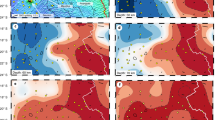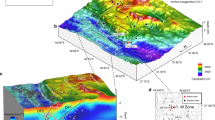Abstract
The shape of the ocean floor has been successfully modelled using the framework of plate tectonics1–4. Lithospheric plates approximately 100 km thick lie above the hotter, less viscous asthensophere. At the ridges, the lithosphere thins. Plate separation is accompanied by creation of new ocean floor as the asthenosphere flows upwards and cools on approaching the surface. As a result, heat is concentrated beneath the ridge axes. Densities are lower due to thermal expansion, so that for iso-static equilibrium the sea floor sits some 6 km shallower than older sea floor, well off axis, where the temperature anomaly is absent. At fast spreading ridges (velocity v > 5 cm yr−1) such as the East Pacific Rise, this description fits well. A central ridge crest is flanked on either side by bathymetry which deepens in agreement with thermal models3–6 at a rate propor tional to the square root of age of creation. However at slow spreading ridges, v < 5 cm yr−1, a major central graben of order 1 km deep replaces the central ridge crest, although the square root of age dependence is observed well away from the axes. Isostatic equilibrium is not achieved7, since the sea floor lies 1–2 km below the equilibrium level. In this report I demonstrate that this graben or median valley can result from steady state dyke intrusion into, and brittle failure of, the axial lithosphere.
This is a preview of subscription content, access via your institution
Access options
Subscribe to this journal
Receive 51 print issues and online access
$199.00 per year
only $3.90 per issue
Buy this article
- Purchase on Springer Link
- Instant access to full article PDF
Prices may be subject to local taxes which are calculated during checkout
Similar content being viewed by others
References
McKenzie, D. P. J. geophys. Res. 72, 6261–6273 (1967).
McKenzie, D. P. & Sclater, J. G. Bull. Volcanol. 33, 101–117 (1969).
Parker, R. L. & Oldenburg, D. W. Nature 242, 137–139 (1973).
Oldenburg, D. W. Geophys. J. R. astr. Soc. 43, 425–451 (1975).
Davis, E. E. & Lister, C. R. B. Earth planet. Sci. Lett. 21, 405–413 (1974).
Parsons, B. & Sclater, J. G. J. geophys. Res. 82, 803–827 (1977).
Watts, A. B. in Continental and Oceanic Rifts, Geodynamic Series No. 8 (ed. Palmason, A. G.) 99–104 (AGU, Washington DC, 1982).
Turcotte, D. L. J. geophys. Res. 79, 2573–2577 (1974).
Tapponnier, P. & Francheteau, J. J. geophys. Res. 83, 3955–3970 (1978).
Leeds, A. R. thesis, Univ. Calif., Los Angeles (1974)
McKenzie, D. P. and Bowin, C. J. geophys. Res. 81, 1903–1915 (1976).
Cochran, J. R. J. geophys. Res. 84, 4713–4729 (1979).
McNutt, M. J. geophys. Res. 84, 7589–7598 (1979).
Gass, I. G. Nature 220, 39–42 (1968).
Williams, H. Geol. Surv. Can. Pap. 72–34, 1–7 (1973).
Salisbury, M. H. & Christensen, N. I. J. geophys. Res. 83, 805–817 (1978).
Duffield, W. A., Jackson, D. B. & Swanson, D. A. in Proc. Sym. Andean and Antarctic Volcanology Problems 577–587 (Giannini and Figli, Napoli, 1976).
Bjornsson, A., Johnsen, G., Sigurdsson, S., Thorbergsson, G. & Tryggvason, E. J. geophys. Res. 84, 3029–3037 (1979).
Pollard, D. D., Delaney, P. T., Duffield, W. A., Endo, E. & Okamura, A. T. Tectonophysics 94, 541–584 (1983).
Davis, P. M. J. geophys. Res. 88, 5826–5834 (1983).
Maruyama, T. Bull. Earthquake Res. Inst. 42, 289–368 (1964).
Flugge, W. Viscoelasticity (Springer Verlag, New York 1975).
Collette, B. J., Verhoef, J. & Mulder, A. F. J. J. Geophys. 47, 91–98 (1980).
Sleep, N. H. J. geophys. Res. 74, 542–549 (1969).
Sleep, N. H. & Biehler, S. J. geophys. Res. 75, 2748–2752 (1970).
Deffreyes, K. S. in Megatectonics of Continents and Oceans (eds Johnson, H. & Smith, B. L., 1922) (Rutgers University Press, New Brunswick, New Jersey 1970).
Anderson, R. N. & Noltimer, H. C. Geophys. J. R. astr. Soc. 34, 137–147 (1973).
Lachenbruch, A. H. J. geophys. Res. 81, 1883–1902 (1976).
Sleep, N. H. & Rosendahl, X. X. J. geophys. Res. 84, 6831–6839 (1979).
Author information
Authors and Affiliations
Rights and permissions
About this article
Cite this article
Davis, P. The median valley, a result of magma fracture beneath mid-ocean ridges. Nature 308, 53–55 (1984). https://doi.org/10.1038/308053a0
Received:
Accepted:
Issue Date:
DOI: https://doi.org/10.1038/308053a0
This article is cited by
Comments
By submitting a comment you agree to abide by our Terms and Community Guidelines. If you find something abusive or that does not comply with our terms or guidelines please flag it as inappropriate.



